Yingying Wang
PCMamba: Physics-Informed Cross-Modal State Space Model for Dual-Camera Compressive Hyperspectral Imaging
May 22, 2025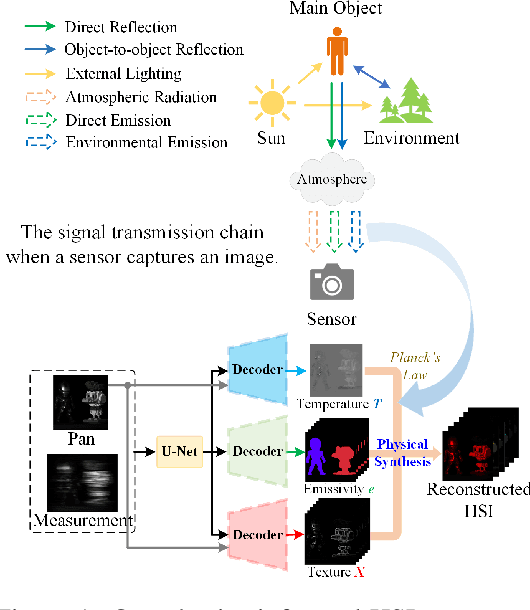
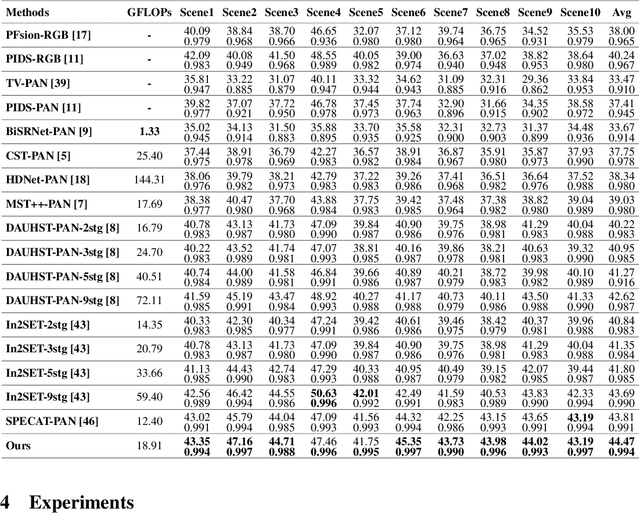
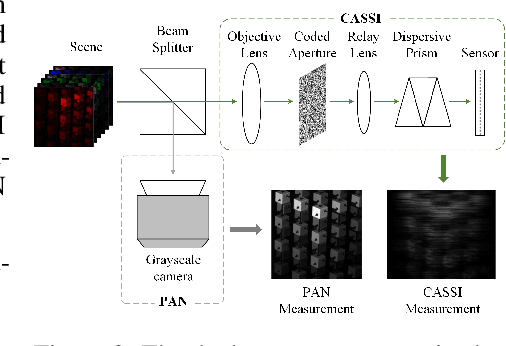
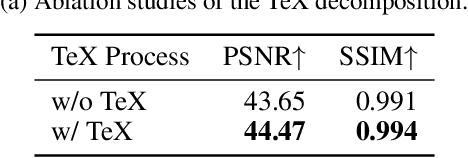
Abstract:Panchromatic (PAN) -assisted Dual-Camera Compressive Hyperspectral Imaging (DCCHI) is a key technology in snapshot hyperspectral imaging. Existing research primarily focuses on exploring spectral information from 2D compressive measurements and spatial information from PAN images in an explicit manner, leading to a bottleneck in HSI reconstruction. Various physical factors, such as temperature, emissivity, and multiple reflections between objects, play a critical role in the process of a sensor acquiring hyperspectral thermal signals. Inspired by this, we attempt to investigate the interrelationships between physical properties to provide deeper theoretical insights for HSI reconstruction. In this paper, we propose a Physics-Informed Cross-Modal State Space Model Network (PCMamba) for DCCHI, which incorporates the forward physical imaging process of HSI into the linear complexity of Mamba to facilitate lightweight and high-quality HSI reconstruction. Specifically, we analyze the imaging process of hyperspectral thermal signals to enable the network to disentangle the three key physical properties-temperature, emissivity, and texture. By fully exploiting the potential information embedded in 2D measurements and PAN images, the HSIs are reconstructed through a physics-driven synthesis process. Furthermore, we design a Cross-Modal Scanning Mamba Block (CSMB) that introduces inter-modal pixel-wise interaction with positional inductive bias by cross-scanning the backbone features and PAN features. Extensive experiments conducted on both real and simulated datasets demonstrate that our method significantly outperforms SOTA methods in both quantitative and qualitative metrics.
FRN: Fractal-Based Recursive Spectral Reconstruction Network
May 21, 2025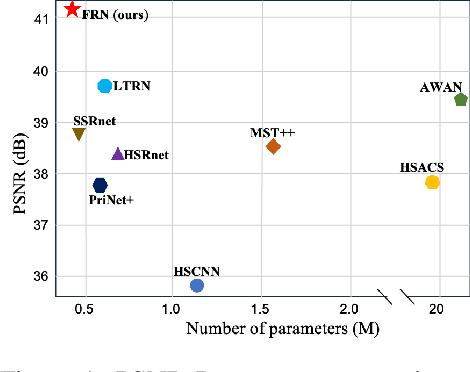

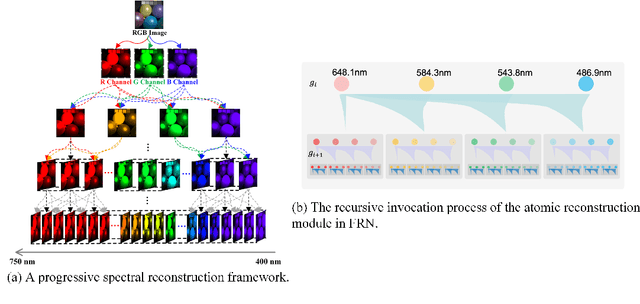

Abstract:Generating hyperspectral images (HSIs) from RGB images through spectral reconstruction can significantly reduce the cost of HSI acquisition. In this paper, we propose a Fractal-Based Recursive Spectral Reconstruction Network (FRN), which differs from existing paradigms that attempt to directly integrate the full-spectrum information from the R, G, and B channels in a one-shot manner. Instead, it treats spectral reconstruction as a progressive process, predicting from broad to narrow bands or employing a coarse-to-fine approach for predicting the next wavelength. Inspired by fractals in mathematics, FRN establishes a novel spectral reconstruction paradigm by recursively invoking an atomic reconstruction module. In each invocation, only the spectral information from neighboring bands is used to provide clues for the generation of the image at the next wavelength, which follows the low-rank property of spectral data. Moreover, we design a band-aware state space model that employs a pixel-differentiated scanning strategy at different stages of the generation process, further suppressing interference from low-correlation regions caused by reflectance differences. Through extensive experimentation across different datasets, FRN achieves superior reconstruction performance compared to state-of-the-art methods in both quantitative and qualitative evaluations.
EMRModel: A Large Language Model for Extracting Medical Consultation Dialogues into Structured Medical Records
Apr 23, 2025Abstract:Medical consultation dialogues contain critical clinical information, yet their unstructured nature hinders effective utilization in diagnosis and treatment. Traditional methods, relying on rule-based or shallow machine learning techniques, struggle to capture deep and implicit semantics. Recently, large pre-trained language models and Low-Rank Adaptation (LoRA), a lightweight fine-tuning method, have shown promise for structured information extraction. We propose EMRModel, a novel approach that integrates LoRA-based fine-tuning with code-style prompt design, aiming to efficiently convert medical consultation dialogues into structured electronic medical records (EMRs). Additionally, we construct a high-quality, realistically grounded dataset of medical consultation dialogues with detailed annotations. Furthermore, we introduce a fine-grained evaluation benchmark for medical consultation information extraction and provide a systematic evaluation methodology, advancing the optimization of medical natural language processing (NLP) models. Experimental results show EMRModel achieves an F1 score of 88.1%, improving by49.5% over standard pre-trained models. Compared to traditional LoRA fine-tuning methods, our model shows superior performance, highlighting its effectiveness in structured medical record extraction tasks.
Pan-LUT: Efficient Pan-sharpening via Learnable Look-Up Tables
Mar 31, 2025
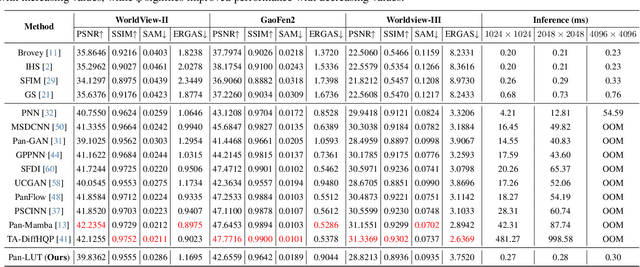
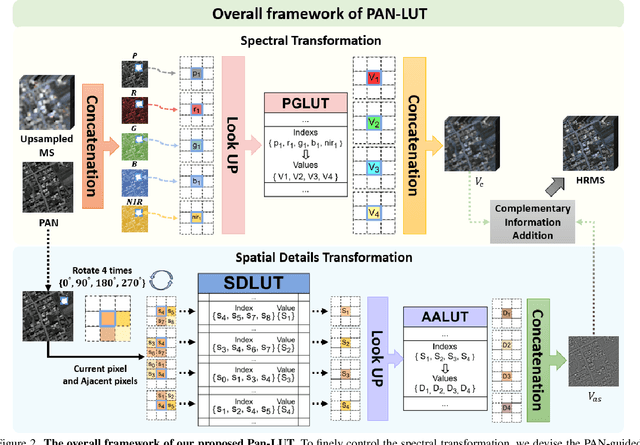
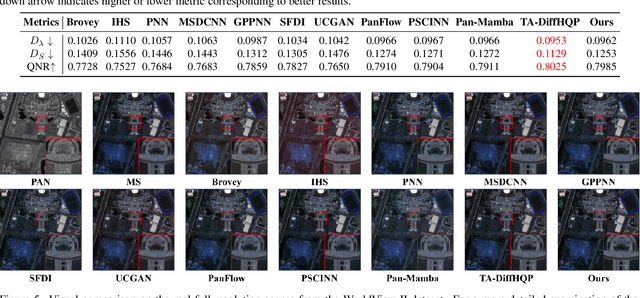
Abstract:Recently, deep learning-based pan-sharpening algorithms have achieved notable advancements over traditional methods. However, many deep learning-based approaches incur substantial computational overhead during inference, especially with high-resolution images. This excessive computational demand limits the applicability of these methods in real-world scenarios, particularly in the absence of dedicated computing devices such as GPUs and TPUs. To address these challenges, we propose Pan-LUT, a novel learnable look-up table (LUT) framework for pan-sharpening that strikes a balance between performance and computational efficiency for high-resolution remote sensing images. To finely control the spectral transformation, we devise the PAN-guided look-up table (PGLUT) for channel-wise spectral mapping. To effectively capture fine-grained spatial details and adaptively learn local contexts, we introduce the spatial details look-up table (SDLUT) and adaptive aggregation look-up table (AALUT). Our proposed method contains fewer than 300K parameters and processes a 8K resolution image in under 1 ms using a single NVIDIA GeForce RTX 2080 Ti GPU, demonstrating significantly faster performance compared to other methods. Experiments reveal that Pan-LUT efficiently processes large remote sensing images in a lightweight manner, bridging the gap to real-world applications. Furthermore, our model surpasses SOTA methods in full-resolution scenes under real-world conditions, highlighting its effectiveness and efficiency.
Unsupervised Low-light Image Enhancement with Lookup Tables and Diffusion Priors
Sep 27, 2024Abstract:Low-light image enhancement (LIE) aims at precisely and efficiently recovering an image degraded in poor illumination environments. Recent advanced LIE techniques are using deep neural networks, which require lots of low-normal light image pairs, network parameters, and computational resources. As a result, their practicality is limited. In this work, we devise a novel unsupervised LIE framework based on diffusion priors and lookup tables (DPLUT) to achieve efficient low-light image recovery. The proposed approach comprises two critical components: a light adjustment lookup table (LLUT) and a noise suppression lookup table (NLUT). LLUT is optimized with a set of unsupervised losses. It aims at predicting pixel-wise curve parameters for the dynamic range adjustment of a specific image. NLUT is designed to remove the amplified noise after the light brightens. As diffusion models are sensitive to noise, diffusion priors are introduced to achieve high-performance noise suppression. Extensive experiments demonstrate that our approach outperforms state-of-the-art methods in terms of visual quality and efficiency.
Neural Modulation Alteration to Positive and Negative Emotions in Depressed Patients: Insights from fMRI Using Positive/Negative Emotion Atlas
Jul 26, 2024
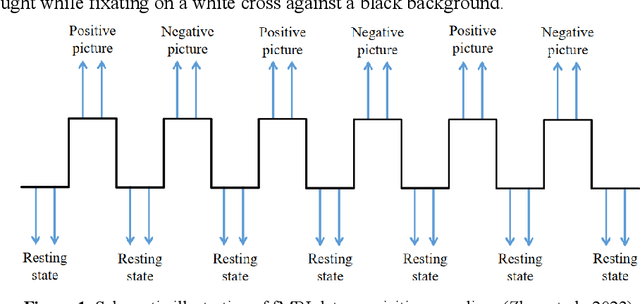


Abstract:Background: Although it has been noticed that depressed patients show differences in processing emotions, the precise neural modulation mechanisms of positive and negative emotions remain elusive. FMRI is a cutting-edge medical imaging technology renowned for its high spatial resolution and dynamic temporal information, making it particularly suitable for the neural dynamics of depression research. Methods: To address this gap, our study firstly leveraged fMRI to delineate activated regions associated with positive and negative emotions in healthy individuals, resulting in the creation of positive emotion atlas (PEA) and negative emotion atlas (NEA). Subsequently, we examined neuroimaging changes in depression patients using these atlases and evaluated their diagnostic performance based on machine learning. Results: Our findings demonstrate that the classification accuracy of depressed patients based on PEA and NEA exceeded 0.70, a notable improvement compared to the whole-brain atlases. Furthermore, ALFF analysis unveiled significant differences between depressed patients and healthy controls in eight functional clusters during the NEA, focusing on the left cuneus, cingulate gyrus, and superior parietal lobule. In contrast, the PEA revealed more pronounced differences across fifteen clusters, involving the right fusiform gyrus, parahippocampal gyrus, and inferior parietal lobule. Limitations: Due to the limited sample size and subtypes of depressed patients, the efficacy may need further validation in future. Conclusions: These findings emphasize the complex interplay between emotion modulation and depression, showcasing significant alterations in both PEA and NEA among depression patients. This research enhances our understanding of emotion modulation in depression, with implications for diagnosis and treatment evaluation.
AGLLDiff: Guiding Diffusion Models Towards Unsupervised Training-free Real-world Low-light Image Enhancement
Jul 23, 2024



Abstract:Existing low-light image enhancement (LIE) methods have achieved noteworthy success in solving synthetic distortions, yet they often fall short in practical applications. The limitations arise from two inherent challenges in real-world LIE: 1) the collection of distorted/clean image pairs is often impractical and sometimes even unavailable, and 2) accurately modeling complex degradations presents a non-trivial problem. To overcome them, we propose the Attribute Guidance Diffusion framework (AGLLDiff), a training-free method for effective real-world LIE. Instead of specifically defining the degradation process, AGLLDiff shifts the paradigm and models the desired attributes, such as image exposure, structure and color of normal-light images. These attributes are readily available and impose no assumptions about the degradation process, which guides the diffusion sampling process to a reliable high-quality solution space. Extensive experiments demonstrate that our approach outperforms the current leading unsupervised LIE methods across benchmarks in terms of distortion-based and perceptual-based metrics, and it performs well even in sophisticated wild degradation.
Training-Free Large Model Priors for Multiple-in-One Image Restoration
Jul 18, 2024Abstract:Image restoration aims to reconstruct the latent clear images from their degraded versions. Despite the notable achievement, existing methods predominantly focus on handling specific degradation types and thus require specialized models, impeding real-world applications in dynamic degradation scenarios. To address this issue, we propose Large Model Driven Image Restoration framework (LMDIR), a novel multiple-in-one image restoration paradigm that leverages the generic priors from large multi-modal language models (MMLMs) and the pretrained diffusion models. In detail, LMDIR integrates three key prior knowledges: 1) global degradation knowledge from MMLMs, 2) scene-aware contextual descriptions generated by MMLMs, and 3) fine-grained high-quality reference images synthesized by diffusion models guided by MMLM descriptions. Standing on above priors, our architecture comprises a query-based prompt encoder, degradation-aware transformer block injecting global degradation knowledge, content-aware transformer block incorporating scene description, and reference-based transformer block incorporating fine-grained image priors. This design facilitates single-stage training paradigm to address various degradations while supporting both automatic and user-guided restoration. Extensive experiments demonstrate that our designed method outperforms state-of-the-art competitors on multiple evaluation benchmarks.
AMSA-UNet: An Asymmetric Multiple Scales U-net Based on Self-attention for Deblurring
Jun 13, 2024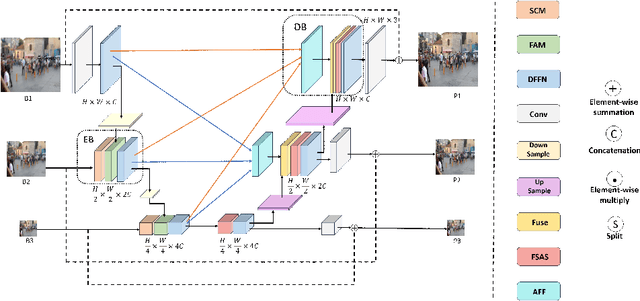
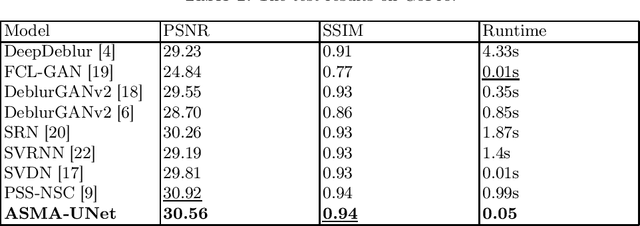
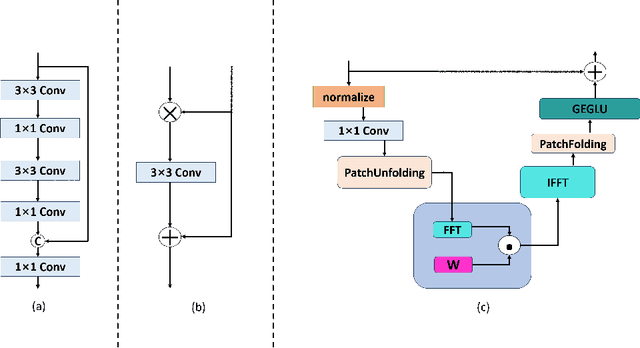

Abstract:The traditional ingle-scale U-Net often leads to the loss of spatial information during deblurring, which affects the deblurring accracy. Additionally, due to the convolutional method's limitation in capturing long-range dependencies, the quality of the recovered image is degraded. To address the above problems, an asymmetric multiple scales U-net based on self-attention (AMSA-UNet) is proposed to improve the accuracy and computational complexity. By introducing a multiple-scales U shape architecture, the network can focus on blurry regions at the global level and better recover image details at the local level. In order to overcome the limitations of traditional convolutional methods in capturing the long-range dependencies of information, a self-attention mechanism is introduced into the decoder part of the backbone network, which significantly increases the model's receptive field, enabling it to pay more attention to semantic information of the image, thereby producing more accurate and visually pleasing deblurred images. What's more, a frequency domain-based computation method was introduced to reduces the computation amount. The experimental results demonstrate that the proposed method exhibits significant improvements in both accuracy and speed compared to eight excellent methods
DDIPrompt: Drug-Drug Interaction Event Prediction based on Graph Prompt Learning
Feb 18, 2024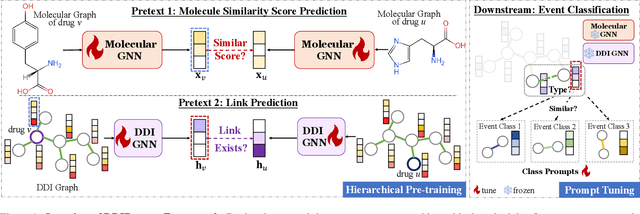
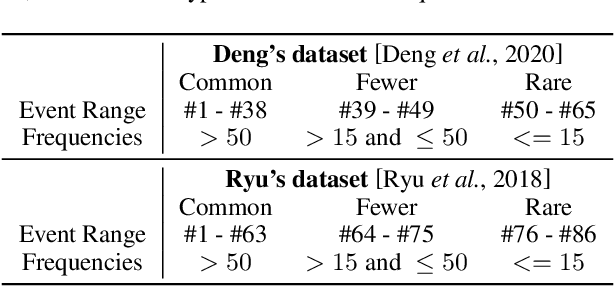
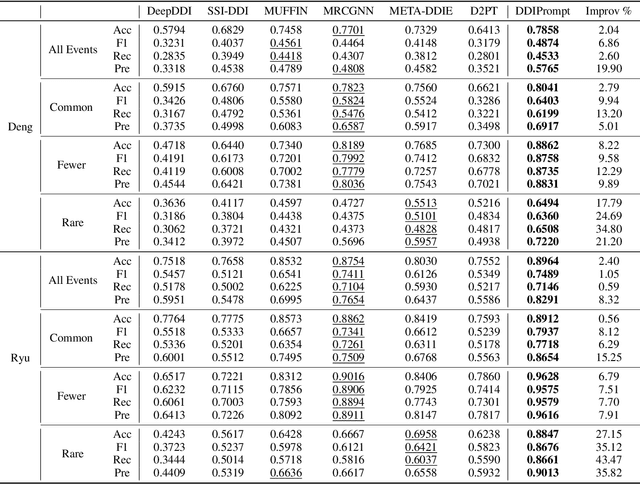
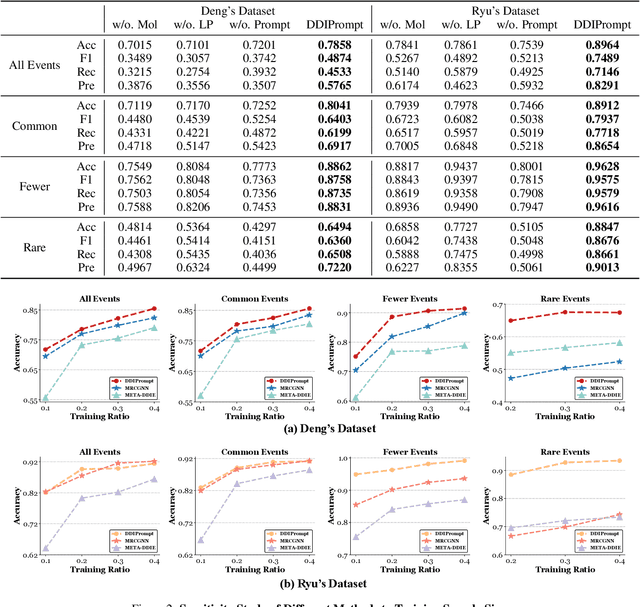
Abstract:Recently, Graph Neural Networks have become increasingly prevalent in predicting adverse drug-drug interactions (DDI) due to their proficiency in modeling the intricate associations between atoms and functional groups within and across drug molecules. However, they are still hindered by two significant challenges: (1) the issue of highly imbalanced event distribution, which is a common but critical problem in medical datasets where certain interactions are vastly underrepresented. This imbalance poses a substantial barrier to achieving accurate and reliable DDI predictions. (2) the scarcity of labeled data for rare events, which is a pervasive issue in the medical field where rare yet potentially critical interactions are often overlooked or under-studied due to limited available data. In response, we offer DDIPrompt, an innovative panacea inspired by the recent advancements in graph prompting. Our framework aims to address these issues by leveraging the intrinsic knowledge from pre-trained models, which can be efficiently deployed with minimal downstream data. Specifically, to solve the first challenge, DDIPrompt employs augmented links between drugs, considering both structural and interactive proximity. It features a hierarchical pre-training strategy that comprehends intra-molecular structures and inter-molecular interactions, fostering a comprehensive and unbiased understanding of drug properties. For the second challenge, we implement a prototype-enhanced prompting mechanism during inference. This mechanism, refined by few-shot examples from each category, effectively harnesses the rich pre-training knowledge to enhance prediction accuracy, particularly for these rare but crucial interactions. Comprehensive evaluations on two benchmark datasets demonstrate the superiority of DDIPrompt, particularly in predicting rare DDI events.
 Add to Chrome
Add to Chrome Add to Firefox
Add to Firefox Add to Edge
Add to Edge